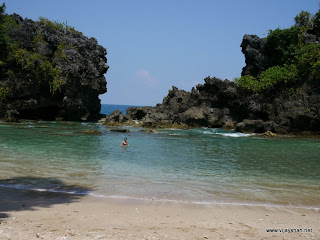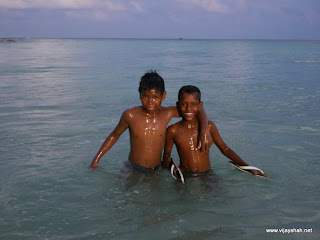“I’ve just been released from prison.”
I leave the prison with wide eyes open to the wonders of the outside
world. I talk to everyone I see, the
fellow inmates and the prison staff most for the first time. It’s been a tough sentence, not so much
physically but mentally I’ve been through a washing machine.
At the prison one cannot talk to the other inmates or prison staff, inclusive
of body language, facial gestures or any other form of communication. No reading or writing material or music is
allowed inside either. Even eye contact
with others is prohibited; a sign reading ‘eyes downcast and you’re bound to be
successful’ is displayed on the ground in line with downcast eyes. The inmates are only permitted two meals a day
with a small snack in the evening. Sleep
is limited to 6 hours of day and the small cells are not much larger than
2x1m. The worst of it though is that the
prisoners have to perform ten and a half hours of meditation a day, every
day. Three of these hours are in forced
discipline where one cannot move for the entire hour. Fortunately the sentence is only ten days
long.
That is the best way to describe entering one's first Vipassana
course. Prison. That is even how the teacher described
it: A self-imposed sentence in a prison
with rules harsher than the most severe penitentiaries’. The harsh rules are there for a reason and as
this is a sentence one has subject on oneself the prisoners/meditators mostly
follow them willingly. I did, finding
the inner strength during the darkest hours to continue. Even when some of the inmates started talking
clandestinely after day 5 I avoided eye contact with them to prevent any unwanted
interaction. That was when the prison
analogy was at it’s most exact. The said
inmates would stand nearby each other about a metre apart during the short
recess recess periods between meditation sessions or after meals. They would look in parallel directions into
the forest or far into the horizon apparently unaware of each other’s presence
and have hushed conversations in secrecy.
When one approaches they stop talking and start again only after one has
passed. But in the enforced silence of
the place they were not fooling anyone, for there is no other reason for
meditators to stand so close to each other and sound travels.
The vow of silence that we took is there like all the rules for a
reason. The meditation course is a huge
journey within the depth of the mind or as the teacher put it a major operation
into the mind. Each meditator is
embarking on an individual journey into the darkest corners of their mind and everyone
experiences it differently. Discussion
and sharing of these experiences can easily lead to confusion, false
expectation and ultimately failure in the meditation. But what is this meditation technique?
Vipassana meditation means ‘to see things as they really are’. It is a process of self-observation that was
discovered by Gotama the Buddha 2500 years ago in India and the path by which
he attained enlightenment. However the
technique was very nearly lost to humanity and only by what appears to be a
series of coincidences over the millennia the technique survived to today. The technique was preserved in a handful of
teachers in Myanmar and handed down orally from teacher to student over
hundreds of years but ultimately was limited to within Myanmar. Again by what appears to be a fortunate
coincident a promising young student well established in the technique found
himself in India to see his parents. A
single isolated course given by this young teacher snowballed with an
unstoppable force. People travelled from
all over India and further afield to learn the technique and in a space of 50
years Vipassana centres have been created all over India and all over the
world. After a gap of almost 2000 years
this technique that had gained so much popularity in the time of the the Buddha
has once again returned to it’s motherland.
The theory behind the technique states that all events are neutral. When they come into contact with the body
through one of the six sense organs (sight, sound, touch, taste, smell and
thought) they create a sensation on the body.
This sensation is itself also neutral but through ignorance we all have
developed a habit of associating these sensations as a pleasant or unpleasant. One could see, smell, hear,
touch, taste something pleasant or unpleasant or have a pleasant or unpleasant
thought. And that, the Buddha says, is
the start of all our miseries. When one
evaluates a particular sensation as pleasant or unpleasant one develops a
craving or aversion to that sensation which themselves are both forms of
misery. When one has a craving for
something but does not receive/attain it they become disappointed –
misery. On the other hand when one
develops a dislike to a particular sensation and they are subject to it they
will too become upset, become miserable.
The other important facet to Vipassana is accepting that nothing is
forever. Everything changes. Thus a pleasant or unpleasant
sensation has only one true characteristic: That it will change. With everything changing all the time any
value we give to these cravings and aversions are bound to result in
misery.
This evaluation of sensations happens deep within the unconscious layers of
the mind and whilst we are all only aware of the surface (conscious) level of
the mind we are locked into this cycle of misery through our ignorance. But what Gotama the Buddha discovered was that
we do not require to be a slave to these evaluations. We can reach into the depths of the mind and
change the nature of it and the way that it reacts to these bodily
sensations. Once craving and aversion
has been eliminated one will no longer be upset by whatever external event that
passes but will always be happy and at peace with the world. That is the path to real happiness and
harmony and the path that led Gotama the Buddha to enlightenment.
All other searches of happiness, through material gains or diversionary
means only strengthen the cravings and aversions our minds have and thus only
strengthen our misery.
The method by which the Buddha discovered to change the nature of the mind
was by making the conscious mind aware of all the sensations that the body feels
that were only previously evaluated by the deep unconscious. That is done by deep meditation.
And deep meditation is what we did. Starting at 4.30am we meditate until 9pm,
every day. Three one hour sittings, one
after breakfast, lunch and dinner were sittings of ‘strong determination’. One could not move at all during the hour and
during the first couple of days the physical pain during the sittings were
excruciating. After the sittings we left
the hall limping off with stiff legs and backs.
These were the hardest tests to control the equanimity of our minds to
these sensations, but eventually the pain subsided as our control of the
sensations grew stronger. Ten and a half
hours of meditation everyday however took it’s toll.
Each morning as I woke up I felt my body had been beaten up the
previous day. But the physical duress
was small compared to what the mind goes through. To be alone with one’s thoughts for so many
hours is very revealing. The mind jumps
to the past, to the future in an endless foray of thoughts and plans, of happy
thoughts and melancholy. One tries to
concentrate on the meditation and within seconds it has departed on some
journey deep into the past. The greatest
lesson on the first couple of days is how wild the mind is. Little by little over the first days the mind
is tamed somewhat and concentration appears easier. It is only then that the real work of
changing the deeper layers of the mind begins and the vipassana meditation
starts.
The course is tough, but the fantastic support of the teachers and support
staff makes this personal journey possible.
As the days go by one realises that the physical prison that we have
subjected ourselves to is nothing compared to the mental prison we are always
in.
Alas 10 days is nowhere enough to transform the mind and no one pretends it
is. Instead the 10 day course is an
introduction to the technique and a tutorial of how to practice the technique
oneself. There are years of work ahead
to reach the goals sought but every step has its benefits and even after 10
days the effects are already felt. I’m
happier as a result.
I'm off to meditate now.






















































